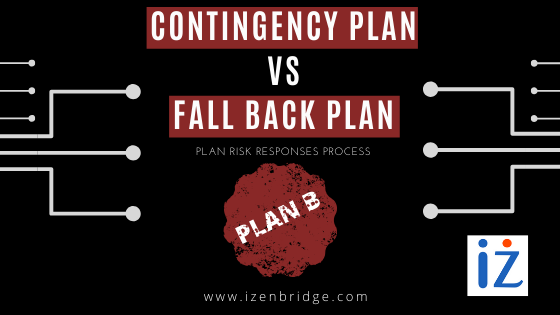

Seldom people feel satisfied after the creation of plan B but what if that plan B is not enough to drive those projects.
This can be understood by a below real-life scenario.
We had a planned vacation to Kerala last year in the month of June. It was expected to rain and I thought I have prepared it by taking Umbrella to the beach but I haven’t prepared for winds though it was predicted in weather forecast and as expected I got drained with water and got the fever. Though I was thinking that I am in good case here being proactively prepared for the rain risk but still I don’t have a fall back plan and If I had taken raincoat with me then I have not spoil my holidays by just being sleeping on the bed.
Now let’s understand from the above scenario, taking umbrella was my contingency plan which I assessed so you can take it as Plan B and due to winds plan B didn’t work so plan C which was wearing raincoat should be my Fallback plan and should be activated only in case Plan B not working. So If I have taken care of Fall back plan then supposedly I have enjoyed my holidays better.
Both Contingency and Fall Back plans are for known risks that are created at the Plan Risk responses process of the Risk management Knowledge area. These methods are used for handling negative risks proactively.
A contingency plan is basically a plan which is designed in case the outcome of the project is getting deviated. It takes care of the known – unknowns risks which are identified and mentioned in the risk register. It is invoked in response when a trigger is raised. A good contingency plan includes both internal (eg resource exit) and external factors (eg natural disasters like an earthquake).
While the Fallback plan is used when a risk that is occurred and a primary response strategy or Contingency plan proves to be insufficient to resolve it then we go to alternative sets of actions/plans. This plan is called a Fallback plan.
| S. No. | Status | Contingency Plan | Fallback Plan |
| 1 | Differences | It is a Primary Risk Response Strategy | It is not a Primary Risk Response Strategy |
| 2 | Activated once pre-accepted risk is triggered | It is activated when Primary response not effective | |
| 3 | Similarities | It is used for known- unknown risk | It is used for known- unknown risk |
| 4 | Created in Plan Risk Response Process under Risk Management Knowledge area | Created in Plan Risk Response Process under Risk Management Knowledge area | |
| 5 | Take Contingency Reserves for funding | Take Contingency Reserves for funding |
Reserve Analysis is done to determine the amount of Contingency and management reserve required for the project. Contingency reserves are determined for known -unknown risks so that project is under schedule and cost baseline. Contingency reserves are part of overall funding requirement. While Management reserves are for unknown risks and are in control of management.
Though both plans are similar in nature as they are part of Risk Management strategies and helps in determining that project is under control only part which differentiates is timing of execution. The fallback plan can be executed only if the Contingency plan is not working.
These plans are best practiced in a traditional way of driving the project. Agile does not have any specific guidelines to determine contingency reserves for the risk as it totally depends on the work provided by the customer. In Agile methodology, all risks are difficult to be identified at the initiating stage. In Agile contingency is tracked throughout the projects for unknown risk and adjusted as per the requirement and analysed to reduce the impact.
Here product owner has a most important role he connects with customer and help in resolving those risks and makes sure the next iteration of development closes these issues.
Let’s understand Fallback plan with below example.
Question – You are the project manager of a software development project. Your team is working on a code and suddenly a risk comes which was identified earlier. You tried to response to the risk but still issue is not resolved. Now what should be your immediate next strategy.
Most of the people would be thinking option1 to Inform the Management as Contingency plan was not able to resolve it which is the primary risk response strategy for identified risk. But this is not correct option as a PM your immediate next step should be to check for Fallback plan in project Plan which is Option 2 as above we are talking about identified risk and primary response has not work.
In the end, I want to conclude that both Contingency plan and Fallback plan are effective methods for responding and managing risk in project management for identified risks.
For unidentified risk other strategies are used like workaround and budget for this is taken from management reserves upon management approval.PM has authority only to use Contingency Reserve so these plans should be made effectively.
| Name | Date | Place | – |
| PMP Certification and Training | 18 Apr – 17 May 2024 | Pune | More Details |
| PMP Certification and Training | 4 May – 2 June 2024 | Chennai | More Details |